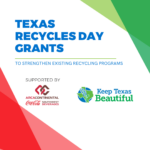by Aishwaryaa Udeshi, Young Texan Ambassador
Cover Photo from Aishwaryaa’s cleanup
Have you ever felt the urge to do something good for the environment, but didn’t know where to start? Or have you participated in a clean-up but felt like it wasn’t making a significant impact? Choosing the right clean-up location can make all the difference in the effectiveness of your efforts, so in this blog post, I’ll walk you through how to make this choice and take further preparation steps.
1. Thoroughly inspect your own community

Before you do anything else, it is imperative that you take a good look around your own community. Chances are that you’ve passed by spots that suffer from littering that you simply haven’t noticed. One of my tips is to “retrace your steps” by thinking through your daily routine. I took the photo below when looking out the window while riding the bus to school and was surprised by the trash by this roadside.
2. Ask around
It’s always a good idea to ask others about potential clean-up locations including peers, teachers, coworkers, neighbors, city officials (as will be discussed in the next step), or other people who can offer guidance or a unique perspective.
3. Contact city officials
If the area you chose is owned by the city, you can also use this step to verify that the land you are planning to clean up isn’t already being regularly cleaned up by another group, so you can focus your attention on generally ignored areas and maximize your impact.
I would recommend reaching out to your city’s Right of Way division since its job directly deals with land, but you can also reach out to your city’s council members for suggestions (for my last clean-up, I contacted both).
4. Make sure you obtain the necessary permissions
There’s a 99.99% chance you don’t own the land you’re cleaning up, so you need to get some sort of express permission (preferably in a referenceable format such as in writing or in email) from whoever does own it allowing you to host a clean-up on their property.
5. Make specific recommendations to your clean-up participants based on the location you chose to ensure their experience is positive

One of the mistakes I made during my clean-up in April is not being more specific in what type of clothing I told my participants to wear. Scouting your area thoroughly won’t help if you don’t communicate what you’ve learned to your participants; for my clean-up, I didn’t realize that I needed to tell them to opt for long pants instead of shorts due to the long grasses and thorns in the area (as you can see in the photo below), so some of them got scratched.
This isn’t an exhaustive list of steps in finding a clean-up location, but rather a general overview that I hope is able to point you in the right direction. Take the first step to making our environment a safer and more beautiful place by taking a look around your neighborhood today, and happy cleaning!



